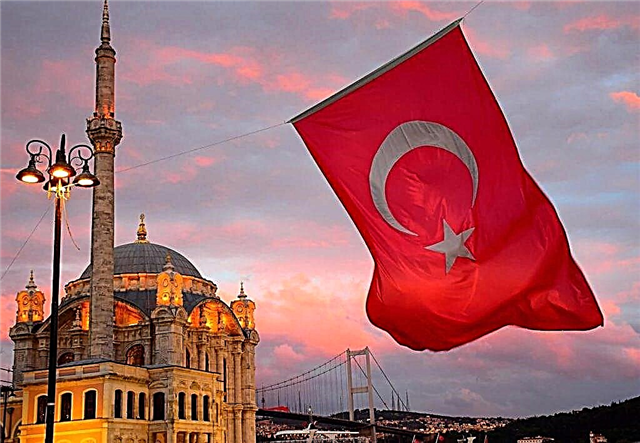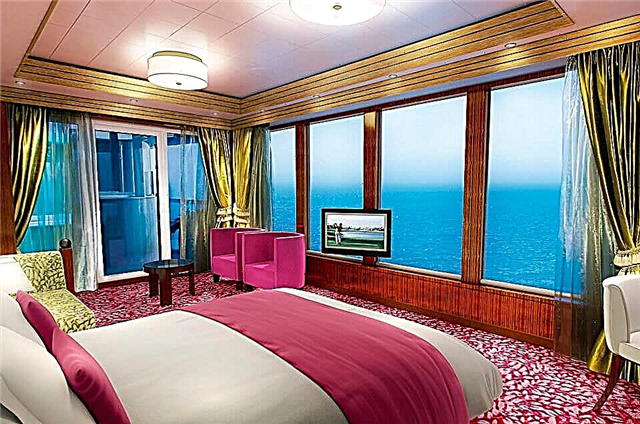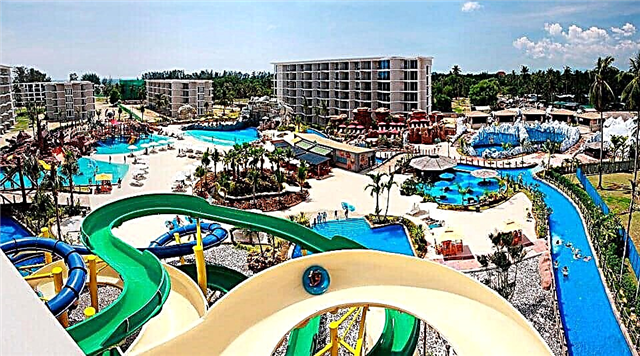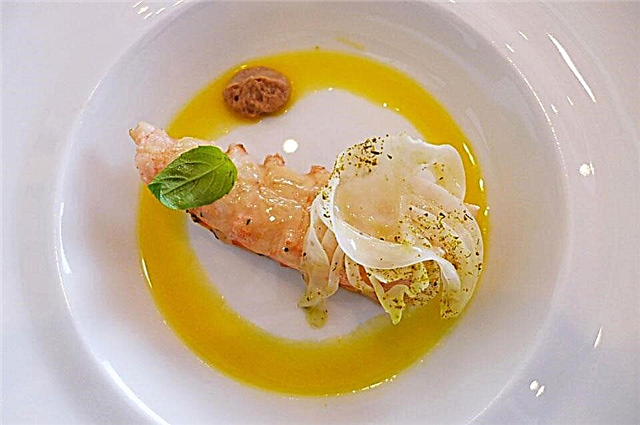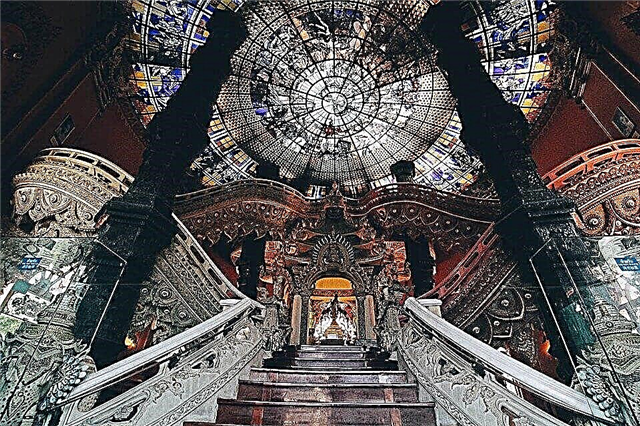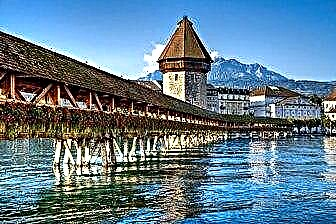Lucerne is nestled among the pastoral landscapes of central Switzerland. It is surrounded by mountains, alpine meadows and green valleys. The city stretches on the shores of the lake of the same name with clear mountain water and picturesque inhabited shores.
Lucerne is as exemplary and prosperous city as Zurich, Geneva or Bern. Tourists will surely enjoy walking along old wooden bridges and cobbled squares, sitting in street cafes and contemplating the architecture of Lutheran cathedrals.
Perhaps the most important reason why travelers come here is the natural landscapes of extraordinary beauty that surround the city. What is the climb to the top of Pilatus or a walk on the mirror-like water of Lake Lucerne!

The best hotels and hotels at affordable prices.
from 500 rubles / day
What to see and where to go in Lucerne?
The most interesting and beautiful places for walking. Photos and a short description.
Kapellbrücke bridge
Wooden bridge over the Royce river, built in 1365. Over the course of seven centuries, many of its structures were replaced, and in 1993, after a severe fire, almost nothing remained of it. However, renovated and opened in 1994, the Kapellbrücke is considered the oldest wooden bridge in Europe. It is also a symbol of Lucerne and an iconic landmark. There are 111 paintings under its roof (78 of them were restored after the fire) with scenes from the history of Switzerland.

Lake Lucerne
The body of water is also known as Lake Lucerne. It is located in the central part of Switzerland in the territory of several cantons at an altitude of 434 meters above sea level. The shores of the lake represent a picturesque and habitable area, which is called the "cradle of Switzerland". There are about 30 species of different fish, which is why the place is quite popular among fishing enthusiasts.

"Dying lion"
A sculptural group dedicated to the Swiss fallen in 1792, who defended the Tuileries Palace during the events of the French Revolution. The monument was created in 1821 by the sculptor L. Akhorn based on a sketch by another famous master B. Thorvaldsen. The monument is a high relief carved into a rocky ledge, which depicts a mighty lion in the last minutes of his life.

Sprobrücke bridge
The bridge of the early 15th century, which, like Kapellbrücke, was also built of wood. In his covered gallery there is a series of unique paintings of the 17th century, united by a common idea called the "Dance of Death" (this plot was quite popular in the gloomy period of the Middle Ages). During the floods of the 16th century, the Sprobrücke was seriously damaged, but later it was completely rebuilt.

Dam "Nadelwehr"
A hydraulic structure on the Royce River, erected in the 1860s. to maintain the water level in Lake Lucerne. The dam was built of wooden stakes that were raised and lowered by hand. At the same time, a sluice is formed, which limits the water flows falling into the Royce River. Nadelwehr was the first of its kind in Europe. The historic dam is located next to the Sprobrücke bridge.

Royce River
The fourth largest river in Switzerland is over 164 km long. It flows through the cantons of Schwyz, Lucerne, Uri, Obwalden and Nidwalden. The waterway originates in the Alps (Saint Gotthard) and flows into Lake Lucerne. Picturesque buildings of past centuries and manicured gardens are located along the banks. Walking along the river is a popular pastime for tourists.

Kornmarkt square
The main square of the historical part of the city, where a bustling public market was previously located, where grain was sold. It is surrounded by picturesque facades of urban mansions of the past centuries. The walls of the houses are painted with frescoes on a variety of themes, depicting scenes from the Bible and everyday life. The place still retains the unique spirit of the Middle Ages.

Old Town Hall
The town hall building is located on the Kornmarkt square. This is one of the first attractions that a tourist arrives in Lucerne pays attention to. Initially, the building was erected for the needs of the grain market, but in the 16th century it was adapted as an administrative building for the city authorities. The appearance of the building has pronounced features of the Renaissance style. Today, the town hall houses a historical museum.

Fortification Wall Museggmauer
The only military fortification of the Middle Ages in the vicinity of Lucerne, which has survived and has survived to this day. The wall was built in the 13th century and was used for its intended purpose until the 19th century. The preserved section of the Museggmauer stretches for almost 900 meters. Watchtowers are located along its entire length. Some of them are open to the public. A hiking trail runs along the wall.

Hotel "Chateau Guch"
The hotel is located on the territory of a castle of the XIX-XX centuries, which stands on the top of a mountain. The surrounding area is designed in the best traditions of "palace" landscape design. In front of the building there is an observation deck with a magnificent view of Lucerne, Lake Lucerne and the valley. Among the guests of "Chateau Guch" are royals, famous actors and famous directors.

Culture and Congress Center
A modern complex consisting of several spacious rooms and a museum. Many events are held here - festivals, congresses, presentations, ceremonies and concerts. The building was erected in a modern high-tech style by the project of the architect J. Nevel in 2000. In terms of acoustics, the halls of the Center are among the best venues in all of Europe.

Swiss Museum of Transport
The museum was founded in 1959. In addition to the exhibition, consisting of various types of transport - airplanes, cars, ships, trains, you can see the collection of the local painter H. Ernie. The museum has a superbly equipped planetarium and an IMAX cinema. There are also some fun rides for kids, such as a mini escalator ride and a fire truck.

Rosengart collection
An art exposition consisting of works by famous masters. 125 paintings by P. Klee, as well as paintings and drawings (sketches) by P. Cezanne, C. Monet, A. Matisse and other famous artists of the 19th-20th centuries are exhibited here. The museum collection also contains photographs of D. Duncan during the Second World War. A separate room is allocated for the works of P. Picasso, which can be considered as a full-fledged gallery.

Richard Wagner Museum
The genius composer R. Wagner came to Switzerland in 1866 and settled in a mansion on the shore of Lake Lucerne. F. Liszt, F. Nietzsche, the Bavarian monarch Ludwig II and other famous personalities of that era often visited his house. According to the memoirs of the composer himself, the happiest moments of his life passed here, which in the best way influenced his future work. Today, the mansion houses a museum in memory of the composer.
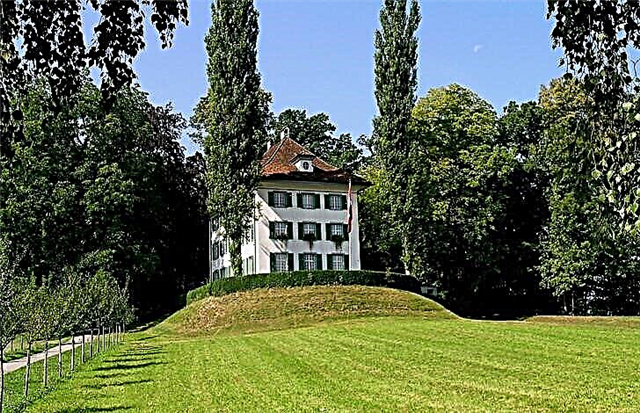
Lucerne Nature Museum
A relatively small exposition is housed in a former orphanage, built in 1811 in the neoclassical style. The leading themes of the collection are the flora and fauna of the region, geological history and environmental problems. The museum often hosts temporary exhibitions, educational lectures and activities for children on nature topics. Part of the collection consists of stuffed animals and birds.

Historical Museum of Lucerne
The exposition consists of costumes, armor, weapons, handicrafts and archival documents from different periods of Lucerne's history.The collection is located in the former Arsenal building. If you wish, you can join an organized excursion that takes place several times during the day. Professional actors work in the museum to create a historical atmosphere.

Panorama of Bourbaki
A panoramic canvas of impressive dimensions by E. Castres, which depicts the passage of the French army of General S. Bourbaki through Switzerland. This event took place during the war between France and Germany in 1870-71. The painting is housed in a round pavilion. Its total area is over 1 thousand square meters. The panel is one of the brightest examples of panoramic painting of the 19th century.

Glacial garden
Geological Park - Museum of Lucerne, which was founded at the end of the 19th century. Its history began with the fact that the city dweller I.V. Amrain accidentally discovered ancient fossils in his backyard while digging up a wine cellar. Based on these findings, the Lucerne Academic Council decided to create a museum. Most of the exhibition is in the open air. The Glacier Garden consists of many pavilions and themed areas.

Jesuit Church
The temple is located in the historical part of Lucerne near the city hall. This is the first religious building in the city, built in the Baroque style. The name of the architect remained unknown, although the temple was built not so long ago - in the second half of the 17th century. According to one version, K. Vogler worked on the building. Despite the fact that the church belongs to the Lutheran confession, its interior is decorated quite magnificently.

Hofkirche church
The temple was built in the 17th century in a mixed architectural style, combining features of the late "German" Renaissance, Baroque and Gothic. Earlier on the site of the Hofkirche there was an abbey of the 8th century, which was destroyed by fire. Bas-reliefs dating from the 14th-15th centuries have survived from the abbey church. The temple is one of the main parishes of the Protestant community in Lucerne.

Lucerne train station
City Central Station, serving suburban and long-distance destinations. The transparent lobby with the original roof topping the building was designed by the Spanish architect S. Calatrava. The facility is owned by a state-owned company that owns Swiss railways. There is a bus station near the train station.

Pilatusban
The railway is more than 4.5 km long and is steeply inclined to the surface at 48 °. It leads to the top of Mount Pilatus. The toothed construction of the blade (for better grip with the wheels) was designed by the ingenious engineer E. Locher at the end of the 19th century. Pilatusban experienced only one modernization in 1937. Since then, its mechanisms have not been reconstructed.

Entlebuch Biosphere Reserve
Natural area of the canton of Lucerne, recognized by UNESCO as the country's first biosphere reserve. The ecosystem is represented by pre-alpine peat valleys and foothills, consisting of karst formations. The reserve covers a vast territory of 400 km². There are hiking trails for tourists passing through the most picturesque places.

Riga
A mountain on the border of the canton of Lucerne, located between the Lake Lucerne and Lake Zug. It rises 1797 meters above sea level. You can climb to the top by rail, cable cars or hiking trails. There are several picturesque towns around the mountain. Local idealistic landscapes attract many tourists here.

Pilatus
The mountain, or rather, the mountain range, which, according to legend, received its name from the name of the procurator Pontius Pilate. There is a belief that his grave is located on one of the slopes. The highest point of the ridge reaches 2121 meters above sea level. Pilatus is located on the border of several cantons - Nidwalden, Obwalden and Lucerne. The Pilatusban cogwheel railway and a cable car ride to its top.



